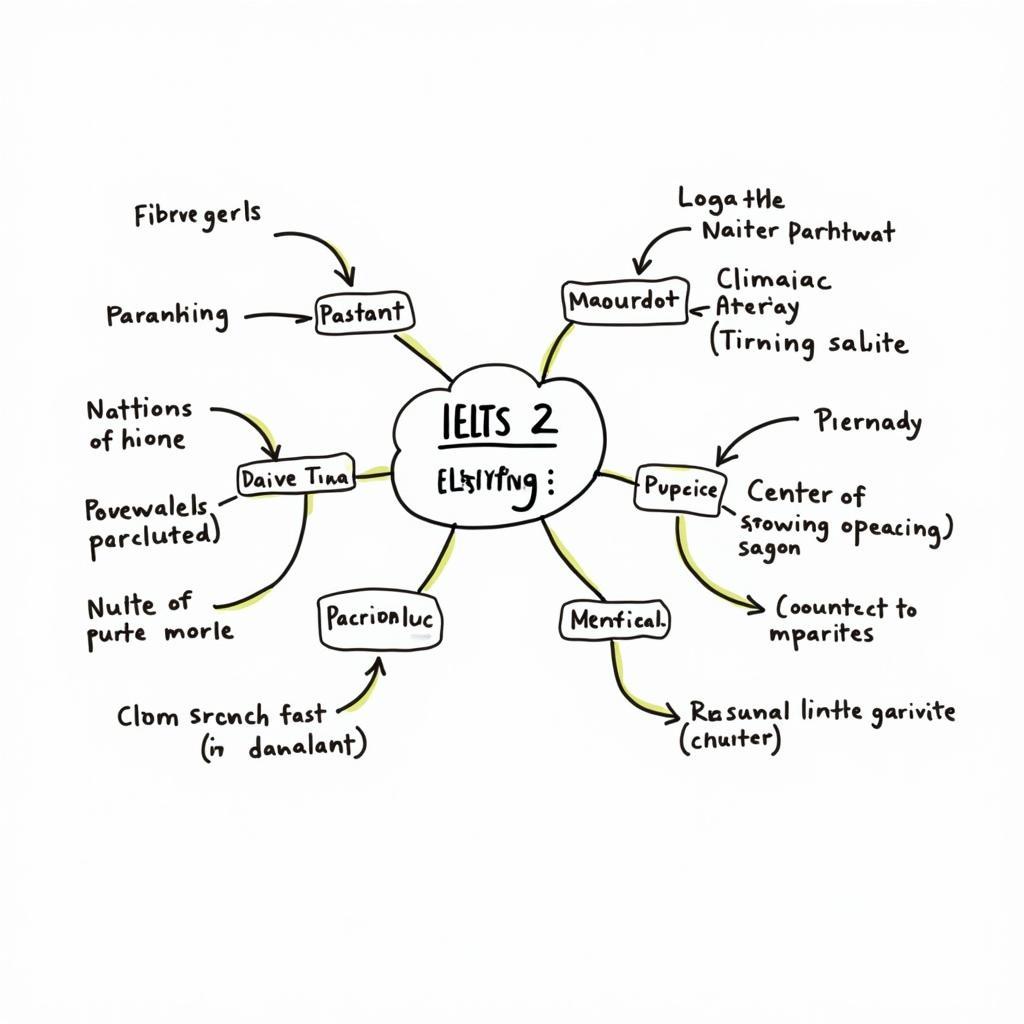Mở bài
Chủ đề Role Of Renewable Energy In Reducing The Impacts Of Climate Change xuất hiện dày đặc trong IELTS Writing Task 2 vì gắn với mối quan tâm toàn cầu về năng lượng sạch và biến đổi khí hậu. Bài viết này giúp bạn: nắm 3 bài mẫu đủ độ dài theo chuẩn thi thật (Band 5-6, 6.5-7, 8-9), phân tích chấm điểm theo 4 tiêu chí chính thức, bộ từ vựng chủ đề môi trường-energies có phiên âm IPA, và 6 cấu trúc câu “ăn điểm” dùng được ngay.
Các đề thi thực tế, đã được xác minh từ các nguồn uy tín (IELTS Liz, IELTS-Blog, British Council) thường xoay quanh:
- “Fossil fuels are the main source of energy in many countries. However, in some countries, the use of alternative sources of energy is encouraged. To what extent is this a positive or negative development?” (nguồn: bộ sưu tập Environment Essay Questions – IELTS Liz)
- “Some people believe that increasing the use of renewable energy is the most effective way to tackle climate change. To what extent do you agree or disagree?” (được tổng hợp từ các đề gần đây đăng trên IELTS-Blog, mục Writing Task 2 – Environment)
- “Governments should invest more in renewable power such as wind and solar rather than fossil fuels. Do you agree or disagree?” (xuất hiện trong các tài liệu luyện thi thuộc British Council/IDP theo chủ đề Environment & Energy)
Trong bài này, tôi chọn một đề phổ biến và có độ “khớp” cao với chủ đề để phân tích chiến lược, đưa bài mẫu và chấm điểm chi tiết.
[internal_link: IELTS Writing Task 2 chủ đề Environment]
1. Đề Writing Part 2
Increasing the use of renewable energy is the most effective way to reduce the impacts of climate change. To what extent do you agree or disagree?
Dịch đề: Gia tăng sử dụng năng lượng tái tạo là cách hiệu quả nhất để giảm thiểu tác động của biến đổi khí hậu. Bạn đồng ý hay không đồng ý ở mức độ nào?
Phân tích đề bài:
- Dạng câu hỏi: Opinion/Agree-Disagree (To what extent…). Bạn cần nêu quan điểm rõ ràng (agree/disagree/partial) và phát triển luận điểm nhất quán.
- Thuật ngữ quan trọng:
- “renewable energy”: năng lượng tái tạo (gió, mặt trời, thủy điện, sinh khối, địa nhiệt).
- “the impacts of climate change”: tác động của biến đổi khí hậu (nắng nóng, hạn hán, nước biển dâng, thời tiết cực đoan).
- “most effective”: “hiệu quả nhất” – hàm ý so sánh với các giải pháp khác như tiết kiệm năng lượng, công nghệ thu giữ carbon, tái trồng rừng, thay đổi hành vi tiêu dùng.
- Lỗi thường gặp:
- Lệch chủ đề sang mô tả ô nhiễm nói chung.
- Khẳng định tuyệt đối nhưng thiếu so sánh/bằng chứng.
- Thiếu phạm vi (energy sector vs. industry, transport, agriculture).
- Dùng số liệu bịa đặt.
- Cách tiếp cận chiến lược:
- Chọn lập trường “agree phần lớn nhưng không tuyệt đối” để mở không gian so sánh.
- Dàn ý 2 thân bài: (1) Vì sao renewables giảm phát thải cốt lõi; (2) Vì sao cần đi kèm các giải pháp bổ trợ để tối đa hiệu quả.
- Dùng ví dụ khái quát, cơ chế logic thay vì số liệu chi tiết.
 Minh họa vai trò năng lượng tái tạo trong giảm tác động khí hậu và cấu trúc bài IELTS
Minh họa vai trò năng lượng tái tạo trong giảm tác động khí hậu và cấu trúc bài IELTS
2. Bài mẫu Band 8-9
Bài Band 8-9 cần: lập trường nhất quán, phát triển luận điểm sâu, ví dụ hợp lý, từ vựng học thuật linh hoạt, câu phức chính xác và liên kết mạch lạc.
Bài luận (300 từ):
In my view, expanding renewables is the backbone of climate mitigation, yet it is not a silver bullet. It addresses the root cause—fossil-based emissions—while also generating co-benefits such as cleaner air and energy security. However, to be truly transformative, it must be integrated with demand-side efficiency, smarter grids, and sector-wide reforms.
To begin with, renewable energy directly displaces coal, oil, and gas in power generation, which is the highest-impact step most countries can take in the near term. Solar and wind have no combustion at the point of use, so switching the grid to low-carbon sources cuts emissions at scale and reduces exposure to fuel price volatility. Crucially, once electricity is cleaned up, other sectors can be decarbonised via electrification—think heat pumps replacing gas boilers or electric buses in cities—thus amplifying the initial gains from renewables. In short, renewables unlock a virtuous cycle: cleaner power enables cleaner industry and transport.
That said, calling renewables the “most effective” solution ignores practical constraints. Intermittency requires grid modernization, storage, and flexible demand. Heavy industry still needs high-temperature heat and may rely on green hydrogen or carbon capture in the medium term. Moreover, without efficiency measures and better urban planning, total energy demand can outpace clean supply, diluting climate benefits. Finally, a just transition—retraining workers and supporting vulnerable communities—determines whether deployment is fast and durable.
In conclusion, I largely agree that scaling renewables is the central pillar of climate action because it tackles emissions at their source and catalyses change across sectors. Yet its effectiveness is maximised when paired with storage, efficiency, and policy frameworks that steer the whole economy toward net zero.
Phân tích Band điểm
| Tiêu chí | Band | Nhận xét |
|---|---|---|
| Task Response (Hoàn thành yêu cầu) | 8.5 | Luận điểm rõ ràng: “central but not sole solution”, so sánh với giải pháp khác, phân tích cơ chế (điện hóa, lưới điện thông minh). Bao quát câu hỏi “most effective” bằng cách công nhận hạn chế. |
| Coherence & Cohesion (Mạch lạc & Liên kết) | 8.0 | Mở–thân–kết rõ ràng, chủ đề từng đoạn nổi bật, liên kết logic “cause–effect” và “constraint–solution”. Dùng từ nối tự nhiên, không lạm dụng. |
| Lexical Resource (Từ vựng) | 8.5 | Từ vựng học thuật chính xác: mitigation, electrification, intermittency, just transition, amplify, pillar. Collocations tự nhiên, ít lặp. |
| Grammatical Range & Accuracy (Ngữ pháp) | 8.0 | Đa dạng câu phức, mệnh đề quan hệ, cụm phân từ. Lỗi ngữ pháp không đáng kể; dấu câu và song song mượt. |
Các yếu tố giúp bài này được chấm điểm cao
- Lập trường “agree phần lớn” xử lý từ khóa “most effective” tinh tế, tránh tuyệt đối hóa.
- Phát triển theo cơ chế nguyên nhân–hệ quả (clean power → electrification of other sectors).
- Nêu rào cản thực tế (intermittency, industrial heat) và chính sách đi kèm (just transition).
- Collocations chuẩn học thuật: grid modernization, demand-side efficiency, central pillar.
- Liên kết ý bằng logic tầng bậc (near term → system-wide change).
- Kết luận quy chiếu lập trường, không mở sang ý mới.
3. Bài mẫu Band 6.5-7
Đặc điểm: nêu quan điểm rõ, lập luận hợp lý nhưng chưa sâu, từ vựng đa dạng vừa phải, đôi khi lặp cấu trúc.
Bài luận (265 từ):
Many people argue that renewable energy is the best way to reduce climate impacts. I mostly agree because clean power cuts emissions from electricity, but I also believe it must be combined with other practical actions.
Firstly, renewables like wind and solar can replace fossil fuels in power plants. When electricity is produced without burning coal or gas, the amount of carbon released falls, and air quality improves. This shift is important because electricity can then be used for more activities, such as charging electric cars or running heat pumps in homes. In this way, renewables create a positive chain effect: cleaner power supports cleaner transport and heating.
However, I do not think renewables alone are the most effective solution in every situation. Solar and wind are not available all the time, so countries need better grids and storage to balance supply and demand. In addition, some industries still need very high heat, and this may require other technologies, for example green hydrogen or even carbon capture. Energy efficiency is also essential because it reduces total demand, making it easier for clean energy to meet our needs.
In conclusion, increasing renewable energy is a leading strategy to fight climate change because it directly tackles emissions from electricity and supports electrification. Nevertheless, to be fully effective, it should be implemented together with grid upgrades, storage, industrial innovation and efficiency programs.
Phân tích Band điểm
| Tiêu chí | Band | Nhận xét |
|---|---|---|
| Task Response (Hoàn thành yêu cầu) | 7.0 | Trả lời đúng trọng tâm, có phản biện hạn chế. Chưa so sánh/đào sâu bằng lập luận chính sách xã hội. |
| Coherence & Cohesion (Mạch lạc & Liên kết) | 7.0 | Bố cục hợp lý, từ nối đủ dùng. Liên kết ý đôi chỗ còn tuyến tính, thiếu phát triển tầng bậc. |
| Lexical Resource (Từ vựng) | 7.0 | Từ vựng chủ đề tốt nhưng chưa thật đa dạng; lặp “renewables/clean power”. Có collocations cơ bản. |
| Grammatical Range & Accuracy (Ngữ pháp) | 6.5 | Có câu phức và mệnh đề quan hệ; cấu trúc chưa đa dạng. Ngữ pháp nhìn chung chính xác. |
So sánh với bài Band 8-9
- Chiều sâu: Band 8-9 phân tích “just transition”, “policy frameworks” và tính hệ thống; bài 6.5-7 dừng ở giải pháp kỹ thuật.
- Từ vựng: Band 8-9 giàu collocations chuyên sâu (demand-side efficiency), bài 6.5-7 dùng từ phổ thông hơn.
- Cấu trúc câu: Bài cao điểm linh hoạt nhiều dạng câu; bài 6.5-7 ít biến hóa, liên kết tuyến tính hơn.
4. Bài mẫu Band 5-6
Đặc điểm: ý đúng hướng nhưng phát triển chưa sâu, liên kết rời, từ vựng hạn chế, có lỗi ngữ pháp/mạo từ/giới từ điển hình người học Việt Nam.
Bài luận (258 từ):
Many people think renewable energy is the best solution to climate change, and I agree in some levels. Renewable sources like wind and solar can replace fossil fuel and reduce emission. This will make the air become more clean and the weather less extreme, which is good for people health and economy.
Firstly, when we build more solar panel and wind farm, we can produce electricity without burning coal or oil. It is not only protect environment but also save money in long term. For example, house with rooftop solar do not pay much for the bill and sometimes sell electric to the grid. So renewable is clearly a effective way to fight climate change.
However, renewable energy also have problems. The sun is not always shining and the wind is not always blow, so sometime there is not enough power for industry. Government should invest to battery and make the grid more strong, and people should use energy careful in peak time. Beside that, some factory still need high temperature and cannot use electric easily.
In conclusion, I agree renewable energy play a big role, but it cannot solve climate change by itself. We also need other solutions like efficiency and new technology to capture carbon from air.
Phân tích Band điểm
| Tiêu chí | Band | Nhận xét |
|---|---|---|
| Task Response (Hoàn thành yêu cầu) | 6.0 | Có quan điểm và ví dụ nhưng lập luận còn giản lược, khẳng định chung chung. |
| Coherence & Cohesion (Mạch lạc & Liên kết) | 5.5 | Có mở–thân–kết nhưng liên kết câu yếu, lặp từ, kết nối ý còn rời rạc. |
| Lexical Resource (Từ vựng) | 5.5 | Từ vựng hạn chế, collocations sai hoặc thiếu tự nhiên (make the air become more clean). |
| Grammatical Range & Accuracy (Ngữ pháp) | 5.5 | Lỗi mạo từ, chia động từ, số nhiều, giới từ; cấu trúc câu đơn lặp lại. |
Những lỗi sai của bài – phân tích & giải thích
| Lỗi sai | Loại lỗi | Sửa lại | Giải thích |
|---|---|---|---|
| agree in some levels | Collocation | agree to some extent | Cụm cố định là “to some extent”, không dùng “in some levels”. |
| reduce emission | Số nhiều | reduce emissions | Emissions là danh từ đếm được theo ngữ cảnh. |
| the air become more clean | Ngữ pháp/tính từ | the air becomes cleaner | Chia động từ số ít; dùng comparative “cleaner”. |
| people health | Mạo từ/sở hữu | people’s health | Cần sở hữu cách. |
| solar panel and wind farm | Số nhiều | solar panels and wind farms | Cấu trúc song song, danh từ số nhiều. |
| a effective way | Mạo từ | an effective way | “Effective” bắt đầu bằng nguyên âm /ɪ/, dùng “an”. |
| renewable energy also have | Hòa hợp CN-ĐT | renewable energy also has | “Energy” không đếm được → has. |
| not always blow | Chia động từ | not always blowing/blow → the wind does not always blow | Cần trợ động từ “does”, chia đúng thì. |
| invest to battery | Giới từ/số nhiều | invest in batteries | Collocation: invest in; batteries số nhiều. |
| use energy careful | Trạng từ | use energy carefully | Cần trạng từ “carefully”. |
Cách Cải Thiện Từ Band 6 Lên Band 7
- Nâng tầm từ vựng với collocations: grid stability, storage capacity, demand-side measures.
- Đa dạng hóa cấu trúc: mệnh đề quan hệ, cụm phân từ, câu điều kiện loại 2/3.
- Làm rõ cơ chế: renewables → decarbonised power → electrification of transport/heating.
- Tránh khẳng định sáo rỗng; thêm điều kiện/ngoại lệ hợp lý.
- Rà lỗi mạo từ (a/an/the), số ít–số nhiều, giới từ (invest in, rely on).
- Kết bài quy chiếu lại câu hỏi “most effective” thay vì nói chung “good”.
 Sơ đồ ý tưởng Task 2 về năng lượng tái tạo, climate change và lập luận band cao
Sơ đồ ý tưởng Task 2 về năng lượng tái tạo, climate change và lập luận band cao
5. Từ vựng quan trọng cần nhớ
| Từ/Cụm từ | Loại từ | Phiên âm | Nghĩa tiếng Việt | Ví dụ (tiếng Anh) và Collocations |
|---|---|---|---|---|
| renewable energy | n. | /rɪˈnuːəbl ˈenədʒi/ | năng lượng tái tạo | Renewable energy is central to mitigation. Collocations: renewable portfolio, renewable deployment |
| decarbonize | v. | /ˌdiːˈkɑːbənaɪz/ | khử carbon | Cities must decarbonize their power supply. Collocations: decarbonize the grid/economy |
| electrification | n. | /ɪˌlektrɪfɪˈkeɪʃn/ | điện hóa | Transport electrification reduces urban pollution. |
| intermittency | n. | /ˌɪntərˈmɪtənsi/ | tính gián đoạn (nguồn) | Intermittency requires storage solutions. |
| grid modernization | n. | /ɡrɪd ˌmɒdənaɪˈzeɪʃn/ | hiện đại hóa lưới | Grid modernization enables higher renewable shares. |
| energy efficiency | n. | /ˈenədʒi ɪˈfɪʃənsi/ | hiệu quả năng lượng | Energy efficiency lowers total demand. |
| storage capacity | n. | /ˈstɔːrɪdʒ kəˈpæsəti/ | dung lượng lưu trữ | We must expand storage capacity for peak hours. |
| just transition | n. | /dʒʌst trænˈzɪʃn/ | chuyển dịch công bằng | A just transition protects vulnerable workers. |
| policy framework | n. | /ˈpɒləsi ˈfreɪmwɜːk/ | khung chính sách | A stable policy framework accelerates investment. |
| tackle climate change | v. phrase | /ˈtækl/ | giải quyết biến đổi khí hậu | We must tackle climate change with systemic reforms. |
| central pillar | n. | /ˈsentrəl ˈpɪlər/ | trụ cột trung tâm | Renewables are the central pillar of mitigation. |
| co-benefits | n. | /ˌkəʊ ˈbenɪfɪts/ | lợi ích đồng thời | Clean air is among the key co-benefits. |
| to a large extent | linker | /ɪkˈstent/ | ở mức độ lớn | I agree to a large extent that renewables are vital. |
| nevertheless | linker | /ˌnevəðəˈles/ | tuy nhiên | Nevertheless, storage remains a bottleneck. |
| rely on | v. phrase | /rɪˈlaɪ ɒn/ | phụ thuộc vào | Heavy industry may rely on green hydrogen. |
6. Cấu trúc câu dễ ăn điểm cao
- Câu phức với mệnh đề phụ thuộc
- Công thức: Mệnh đề chính + because/although/when/if + mệnh đề phụ.
- Ví dụ từ bài Band 8-9: “Crucially, once electricity is cleaned up, other sectors can be decarbonised via electrification.”
- Vì sao ghi điểm: Thể hiện quan hệ nhân–quả/thời gian rõ ràng, tăng mạch lạc.
- Ví dụ bổ sung:
- When storage becomes affordable, adoption will accelerate.
- Although costs are falling, integration challenges persist.
- Lỗi thường gặp: Thiếu chủ ngữ trong mệnh đề phụ; dùng thì không nhất quán.
- Mệnh đề quan hệ không xác định (non-defining relative clause)
- Công thức: Danh từ, which/who + mệnh đề bổ sung, …
- Ví dụ: “Solar and wind have no combustion at the point of use, which cuts emissions at scale.”
- Ghi điểm: Bổ sung thông tin mượt, tăng độ tinh tế.
- Ví dụ:
- Green hydrogen, which is still expensive, may support heavy industry.
- The grid, which is outdated in many countries, needs upgrades.
- Lỗi: Thiếu dấu phẩy trước mệnh đề không xác định.
- Cụm phân từ (participle phrases)
- Công thức: V-ing/V-ed mở rộng thông tin.
- Ví dụ: “Calling renewables the ‘most effective’ solution ignores practical constraints.”
- Ghi điểm: Cô đọng, phong cách học thuật.
- Ví dụ:
- Relying solely on solar, policymakers risk supply gaps.
- Designed poorly, incentives may distort markets.
- Lỗi: Treo chủ ngữ (dangling modifier).
- Câu chẻ (Cleft sentences)
- Công thức: It is/was + X + that/who + mệnh đề.
- Ví dụ: “It is grid modernization that enables higher renewable penetration.”
- Ghi điểm: Nhấn mạnh điểm then chốt.
- Ví dụ:
- It is energy efficiency that delivers the fastest savings.
- It is policy certainty that unlocks private capital.
- Lỗi: Lạm dụng gây nặng nề.
- Câu điều kiện nâng cao
- Công thức: If + should/were to + V, …; hoặc mixed conditionals.
- Ví dụ: “If renewables are to be truly transformative, they must be integrated with smarter grids.”
- Ghi điểm: Diễn đạt giả định, điều kiện chính sách.
- Ví dụ:
- If governments were to streamline permits, projects would scale faster.
- If storage had been deployed earlier, curtailment would have fallen.
- Lỗi: Sai thì với điều kiện không có thật.
- Đảo ngữ
- Công thức: Only when/Not until/Seldom + trợ động từ + S + V.
- Ví dụ: “Only when storage is widespread will intermittency cease to be a major concern.”
- Ghi điểm: Phong cách trang trọng, nhấn mạnh.
- Ví dụ:
- Seldom has policy been so decisive in energy transitions.
- Not until costs declined did adoption surge.
- Lỗi: Quên đảo trợ động từ, dùng sai thì.
7. Checklist Tự Đánh Giá
- Trước khi viết:
- Xác định dạng bài (Agree/Disagree; mức độ).
- Chọn 2-3 luận điểm trụ cột, có cơ chế và ví dụ.
- Lập dàn ý: Thesis – BP1 (vì sao hiệu quả) – BP2 (điều kiện/hạn chế) – Conclusion.
- Trong khi viết:
- Mở bài nêu lập trường rõ ràng.
- Mỗi đoạn 1 ý chính, có giải thích–ví dụ–hệ quả.
- Dùng liên kết logic (therefore, however, in turn).
- Sau khi viết:
- Soát lỗi mạo từ (a/an/the), số ít–số nhiều, giới từ (invest in, depend on).
- Tránh lặp từ; thay bằng collocations/đồng nghĩa.
- Kiểm từ khóa đề: “most effective” đã được xử lý chưa?
- Quản lý thời gian:
- 3-4 phút phân tích đề và lập dàn ý.
- 25–28 phút viết.
- 3–5 phút soát lỗi nhanh theo checklist.
Kết bài
Chủ đề role of renewable energy in reducing the impacts of climate change là “món tủ” của IELTS Writing Task 2. Để đạt band cao, bạn cần: nêu lập trường rõ ràng, chứng minh cơ chế tác động (clean power → electrification), thừa nhận giới hạn (intermittency, industrial heat) và đề xuất điều kiện đi kèm (storage, efficiency, policy). Hãy luyện theo ba bài mẫu ở trên, ghi nhớ bộ từ vựng học thuật và 6 cấu trúc câu then chốt để nâng chất lượng lập luận.
Lộ trình cải thiện thực tế: 2–4 tuần luyện viết theo dàn ý cố định, sau đó nâng cấp từ vựng–cấu trúc và học cách soát lỗi có hệ thống. Viết 2–3 bài/tuần, nhận phản hồi từ cộng đồng học hoặc giáo viên, và lặp lại. Bạn có thể bắt đầu ngay bằng cách chọn một đề trong phần đầu và đăng bài viết của mình để nhận góp ý. Tài nguyên bổ sung: Environment Essay Questions (IELTS Liz), bài mẫu theo chủ đề trên IELTS-Blog, kho đề và mẹo viết của British Council/IDP.


